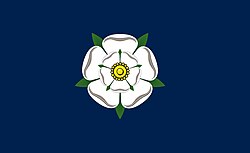The Yorkshire Portal
Yorkshire (/ˈjɔːrkʃər, -ʃɪər/ YORK-shər, -sheer) is an area of Northern England which was historically a county. Despite no longer being used for administration, Yorkshire retains a strong regional identity. The county was named after its original county town, the city of York.
The south-west of Yorkshire is densely populated, and includes the cities of Leeds, Sheffield, Bradford, and Wakefield. The north and east of the county are more sparsely populated, however the north east includes the southern part of the Teesside conurbation, and the port city of Kingston upon Hull is located in the south-east. York is located near the centre of the county. Yorkshire has a coastline to the North Sea to the east. The North York Moors occupy the north east of the county, and the centre contains the Vale of Mowbray in the north and the Vale of York in the south. The west contains part of the Pennines, which form the Yorkshire Dales in the north-west. (Full article...)
Selected article

The history of Sheffield, a city in South Yorkshire, England, can be traced back to the founding of a settlement in a clearing beside the River Sheaf in the second half of the 1st millennium AD. The area now known as Sheffield had seen human occupation since at least the last ice age, but significant growth in the settlements that are now incorporated into the city did not occur until the Industrial Revolution.
Following the Norman conquest of England, Sheffield Castle was built to control the Saxon settlements and Sheffield developed into a small town, no larger than Sheffield City Centre. By the 14th century Sheffield was noted for the production of knives, and by 1600 it had become the main centre of cutlery production in England, overseen by the Company of Cutlers in Hallamshire. In the 1740s the crucible steel process was improved by Sheffield resident Benjamin Huntsman, allowing a much better production quality. At about the same time, the silver plating process which produced Sheffield Plate was discovered. The associated industries led to the rapid growth of Sheffield; the town was incorporated as a borough in 1843 and granted a city charter in 1893.
Sheffield remained a major industrial city throughout the first half of the 20th century, but the downturn in world trade following the 1973 oil crisis, technological improvements and economies of scale, and a wide-reaching rationalisation in steel production throughout the European Economic Community led to the closure of many of the steelworks from the early 1970s onward. Urban and economic regeneration schemes, initiated in the late 1980s, have since transformed the city. (read more . . . )
Selected image

Gaping Gill on Ingleborough Hill is, at 105 metre deep, one of the deepest potholes in the Yorkshire Dales, and one of many entrances to the Gaping Gill cave system. (read more . . . )
Selected biography
Saint William of York, (d. 1154) also known as William FitzHerbert, William I FitzHerbert and William of Thwayt, was an English priest and Archbishop of York. FitzHerbert is unusual in having been Archbishop of York twice, both before and after his rival Henry Murdac. He was a relative of King Stephen of England, and the king helped secure FitzHerbert's election to York after a number of candidates had failed to secure papal confirmation. FitzHerbert faced opposition from the Cistercians who, after the election of the Cistercian Pope Eugenius III, managed to have the archbishop deposed in favor of the Cistercian Murdac. From 1147 until 1153, FitzHerbert worked to secure his restoration to York, which he finally achieved after the deaths of both Murdac and Eugenius. He did not retain the see long, as he died shortly after returning to York, allegedly having been poisoned. After his death miracles were reported at his tomb, and in 1227 he was declared a saint. (read more . . . )
Selected list -

Selected Did You Know . . .

- ... that Fountains Fell, (pictured), a mountain in the Yorkshire Dales, England, is named after Fountains Abbey whose monks grazed sheep there in the 13th century?
- ...that the Rotunda Museum houses one of the foremost collections of Jurassic geology on the Yorkshire Coast?
- ... that All Saints Church, Helmsley, contains two chapels dedicated to different saints?
- ...that an estimated 20 people died after eating peppermint humbugs that were accidentally made with arsenic in the 1858 Bradford sweets poisoning?
General images -
Subcategories
Selected panorama

Topics
Related portals
WikiProjects
Things you can do
Associated Wikimedia
The following Wikimedia Foundation sister projects provide more on this subject:
-
 Commons
Commons
Free media repository -
 Wikibooks
Wikibooks
Free textbooks and manuals -
 Wikidata
Wikidata
Free knowledge base -
 Wikinews
Wikinews
Free-content news -
 Wikiquote
Wikiquote
Collection of quotations -
 Wikisource
Wikisource
Free-content library -
 Wikiversity
Wikiversity
Free learning tools -
 Wikivoyage
Wikivoyage
Free travel guide -
 Wiktionary
Wiktionary
Dictionary and thesaurus











































